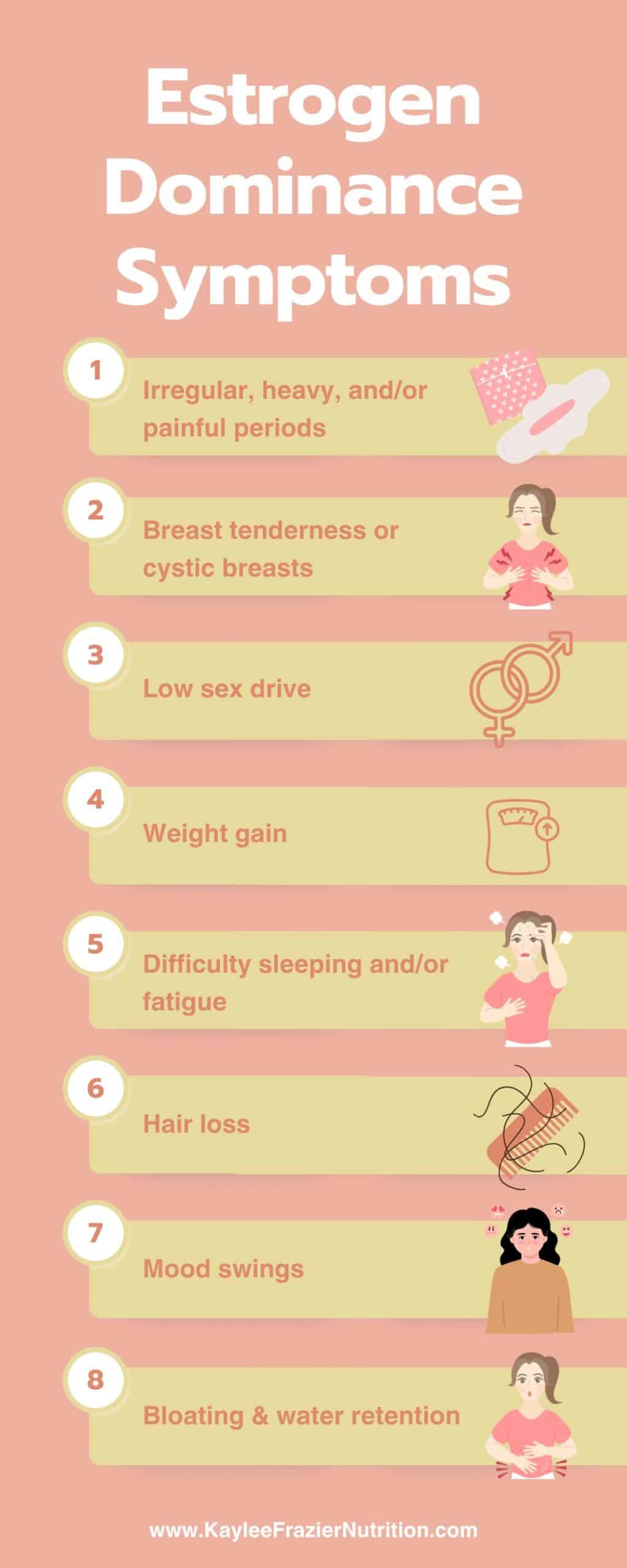Estrogen dominance is a common hormonal imbalance that affects women. It leads to many uncomfortable symptoms and research even suggests it can increase the risk of certain types of cancer (1).
While the causes of estrogen dominance can be multifactorial, changes to your diet can make a substantial impact on balancing estrogen levels and reducing estrogen dominance. And thereby reducing the symptoms and negative outcomes associated with excess estrogen.
In this article, we are going to cover what estrogen dominance is – including the causes and common symptoms.

What is estrogen dominance?
Estrogen and progesterone are two of the main sex hormones that fluctuate during a woman’s monthly cycle.
But, these two hormones are especially important because they are considered counterparts with opposing effects on the female body. This means keeping them in balance is especially important in order to feel your best and function optimally.
Estrogen dominance is the hormonal imbalance that occurs when estrogen is high compared to progesterone. It is important to note that estrogen dominance doesn’t always mean you have high levels of estrogen.
Rather, the balance between estrogen and progesterone is disturbed with estrogen dominance. And it is this imbalance that ultimately leads to those pesky symptoms you are likely experiencing.
What are estrogen dominance symptoms?
When estrogen and progesterone are out of balance, women can experience some pretty uncomfortable symptoms. Estrogen dominance symptoms include:
- Irregular, heavy, and/or painful periods
- Breast tenderness or cystic breasts
- Low sex drive
- Weight gain
- Difficulty sleeping and/or fatigue
- Hair loss
- Mood swings
- Bloating & water retention
And when left unchecked, this imbalance can lead to difficulty getting pregnant, fibroids, increased risk of certain types of cancer, and heart issues (2).

What causes estrogen dominance?
Now, remember that estrogen dominance has to do with the balance between estrogen and progesterone. With that in mind, let’s dive into the 2 main types of estrogen dominance.
Frank Estrogen Dominance:
With frank estrogen dominance, the level of estrogen is abnormally high. In this scenario, progesterone is usually in a normal range.
Frank estrogen dominance, or high levels of estrogen occur from:
- Excessive Estrogen Production: Conditions such as PCOS can cause excessive production of estrogen.
- Poor Estrogen Detoxification: Your body detoxifies estrogen in the liver. If the detox pathway isn’t functioning properly, estrogen destined for elimination remains in circulation longer than intended.
- Poor Gut Health: After detoxification in the liver, the estrogens tagged for excretion are sent to the gut to be eliminated the the stool. But, gut dysbiosis (imbalances in gut bacteria) can interfere with the excretion process and allow some of the estrogens tagged for excretion to get reabsorbed into circulation.
- Endocrine Disruptors & Xenoestrogens: Many pollutants and toxins found in pesticides, plastics, beauty products, and chemicals mimic the action of estrogen and disrupt the estrogen balance.
- Obesity: Fat cells make estrogen so having more adipose (fat) tissue increases the risk of excess estrogen production.
- Hormonal Birth Control: Birth control pills include synthetic estrogen that contribute to excessive estrogen burden in the body.
Relative Estrogen Dominance:
With relative estrogen dominance, the level of estrogen is too high relative to the amount of progesterone. In this scenario, estrogen levels may be considered normal but progesterone levels are low.
Relative estrogen dominance, or low levels of progesterone occur from:
- Stress: Chronic stress means elevated cortisol. High cortisol puts a damper on your body’s ability to make progesterone.
- Anovulation: Progesterone is only made after ovulation. If you are not regularly ovulating, then your body is not producing progesterone to balance the effects of estrogen. PS – you can learn if you are ovulating from this article!
- Poor Nutrition: Poor nutrient intake can impact progesterone levels, specifically vitamin B6, vitamin C, magnesium, omega-3 fatty acids, zinc, and overall low calorie intake.
How to tell if you are estrogen dominant?
If you suffer from estrogen dominance symptoms, you may be wondering how to tell if you are actually estrogen dominant.
Unfortunately, a simple blood test might not give you all the answers you are craving. Here’s why.
In order to get accurate readings for hormone levels from blood tests, you have to test at the right time. Hormones fluctuate daily during a woman’s monthly cycle so you have to catch hormones on the right days in order to get an accurate picture of highs and lows.
And second, like we talked about earlier, estrogen dominance isn’t just about having high estrogen. It is having high estrogen relative to progesterone. So even if your estrogen level comes back looking great (or even low!), it doesn’t mean that there isn’t an imbalance.
One test that I have used before to identify hormonal imbalances is the DUTCH test. The test uses dried urine to look at hormones and their metabolites to provide a picture of how your hormones fluctuate over time.
How can we help estrogen dominance?
Luckily, there are many things you can do in your diet and lifestyle to help estrogen dominance symptoms.
And of course, talking with your own provider can help you come up with an individualized plan to relieve your estrogen dominance symptoms.
